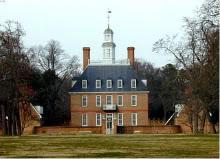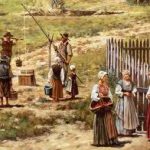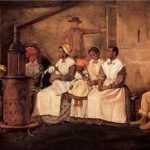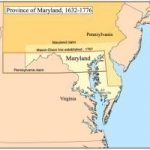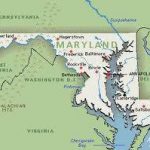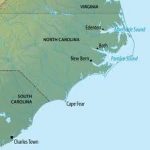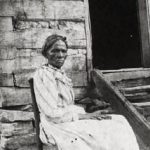| Governor’s Palace at Williamsburg |
Thirteen Original Colonies
At the beginning of the seventeenth century all the eastern portion of North America, which afterward became the thirteen original states, was known as Virginia. On May 14, 1607, the Virginia Company explorers landed on Jamestown Island, and established the Virginia colony on the banks of the James River, sixty miles from the mouth of the Chesapeake Bay.
Early Virginia was a death trap. Of the first 3,000 immigrants, all but 600 were dead within a few years of arrival. Virginia was a society in which life was short, diseases ran rampant, and parentless children and multiple marriages were the norm.
Unlike New England, which was settled mainly by families, most of the settlers of Virginia were single men bound in servitude. Before the colonies turned decisively to slavery in the late seventeenth century, planters relied on white indentured servants from England, Ireland, and Scotland. They wanted men, not women. During the early and mid-seventeenth century, as many as four men arrived for every woman.
The Barter System
There were no banks in colonial Virginia, and very few people used currency and coins to buy goods and services. A form of trading and exchanging, called barter was commonly used instead of money. Colonial Virginians could buy goods from merchants and shopkeepers on credit, and pay their debts when their crops were harvested and sold.
Tobacco was often used as money. It was grown and then sold in England as a cash crop – a crop that is grown to sell for money rather than for use by the planter. Inspectors at public warehouses where tobacco was sold issued these certificates, that were also issued for transacting business. When a colonial planter bought and traded goods with England, they were exchanged for English pounds, shillings, and pence.
Native Americans
Almost immediately after landing, the colonists were under attack from their on-again off-again enemy, the natives. As a result, in a little over a months’ time, the newcomers managed to “bear and plant palisades” enough to build a wooden fort.
The early colonists discovered that Virginia was an ideal place to cultivate tobacco, which had been recently introduced into Europe. Since tobacco production rapidly exhausted the soil of nutrients, the English began to acquire new lands along the James River, encroaching on Native American hunting grounds.
By 1622, the friendly chief Powhatan – father of Pocahontas – was dead, and his brother Opechancanough ruled the region. He pretended friendship with settlers but made plans to drive them from his country. On March 22, 1622, along a 140 mile front covering most of the colonized area, the Native Americans attacked the English settlements and killed 347 colonists. The whites, recovering from the shock, pursued the savages with merciless fury, putting to death a far greater number than they had lost.
Twenty-two years later, an aged Opechancanough made his last effort to banish the English, killing over two hundred colonists. Opechancanough was captured and carried wounded on a stretcher to Jamestown, where he was shot by the soldier who was supposed to be protecting him.
A Royal Colony
In 1624, the Virginia Company, after a severe struggle with the Crown, was deprived of its charter, and Virginia became a royal colony, and so it continued to the war of the Revolution. But the change had little effect on the colony, because Charles I was so occupied with troubles at home that he paid little attention to the government of Virginia, and popular government continued to flourish. But of the six thousand people who had come from England before 1625, only one-fifth had survived.
Tobacco
Raising tobacco required a large labor force. Virginians experimented with a variety of labor sources, including Indian slaves, penal slaves, and white indentured servants. Convinced that England was overpopulated with vagabonds and paupers, the colonists imported surplus Englishmen to raise tobacco and to produce dyestuffs, potash, furs, and other goods that England had imported from other countries.
Typically, young men or women in their late teens or early twenties signed a contract of indenture, in exchange for transportation to the New World. The servant worked for four to seven years without wages. Servants could be bought, sold, or leased, and could also be physically beaten for disobedience. Unlike slaves, however, they were freed after their term of service expired, and they received a small cash payment of freedom dues.
Slavery
Historians now know that small numbers of Africans lived in Virginia before 1619, the year a Dutch ship sold some twenty blacks to the colonists, but it wasn’t until the 1680s that black slavery became the dominant labor system on plantations there. As late as 1640, there were probably only 150 blacks in Virginia, and in 1650, only 300.
Until the mid-1660s, the number of white indentured servants was sufficient to meet Virginia’s labor needs. Then, in the mid-1660s, the supply of white servants fell sharply. Meanwhile, Virginia became less attractive as the land grew scarcer. Many new settlers preferred to migrate to Pennsylvania or the Carolinas, where opportunities seemed greater.
To replenish its labor force, planters in the Chesapeake region increasingly turned to enslaved Africans. Most of these slaves weren’t brought directly from Africa, but came from Barbados and other Caribbean colonies or from the Dutch colony of New Netherlands, which the English had conquered in 1664 and renamed New York.
In 1680, just seven percent of the population of Virginia and Maryland consisted of slaves; twenty years later, the figure was 22 percent.
The status of blacks in seventeenth century Virginia was extremely complex. Some were never free; others were allowed to own property and marry and were freed after a term of service. Some were even allowed to testify against whites in court and to purchase white servants.
During the 1660s and 1670s, Virginia adopted laws specifically designed to denigrate blacks. These laws banned interracial marriages and sexual relations, and deprived blacks of property. Other laws prohibited blacks from bearing arms or traveling without written permission.
In 1669, Virginia became the first colony to declare that it wasn’t a crime to kill an unruly slave in the ordinary course of punishment. That same year, Virginia also prohibited masters from freeing slaves unless the freedmen were deported from the colony. Virginia also voted to banish any white man or woman who married a black, mulatto, or Indian.
By 1680, the number of slaves in Virginia had risen to 3,000 and by 1704, they numbered 10,000.
The Colony Prospers
In spite of many drawbacks of the unworthy governors and their frequent quarrels with the assembly and the people, Virginia continued to prosper, and by the end of the seventeenth century the population numbered 100,000. The people up to this time were almost wholly English, but in 1700 several hundred Huguenots made their home in the colony.
About 1730, the Scotch-Irish began to settle in large numbers in the Shenandoah Valley, and soon after these came the Germans. The frontier was moved gradually westward from the Tidewater counties until it had crossed the summit of the Alleghenies. These new settlers brought new modes of life, new religious customs, and new democratic ideas into Virginian society.
In the course of the next half century, many vital changes were brought about, as the abolition of primogeniture and entail, the separation of Church and State, and religious toleration. Thus the various nationalities, blending slowly into one people, spent the remainder of the colonial period hewing away the forests and laying the foundations of a great state.
SOURCES
Virginia
Colony of Virginia
